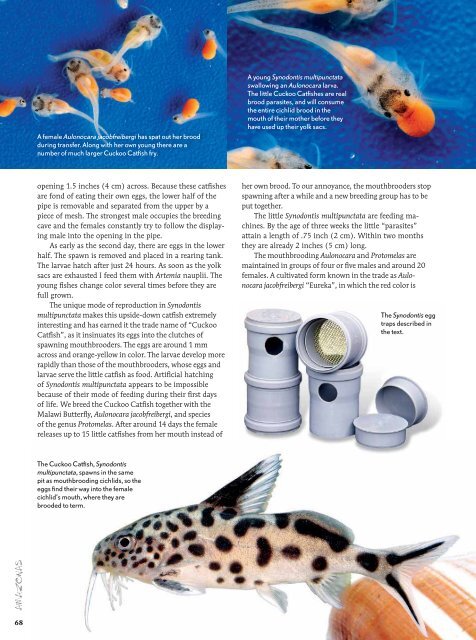Angels - PageSuite
Angels - PageSuite
Angels - PageSuite
Create successful ePaper yourself
Turn your PDF publications into a flip-book with our unique Google optimized e-Paper software.
AMAZONAS<br />
68<br />
A female Aulonocara jacobfreibergi has spat out her brood<br />
during transfer. Along with her own young there are a<br />
number of much larger Cuckoo Catfish fry.<br />
opening 1.5 inches (4 cm) across. Because these catfishes<br />
are fond of eating their own eggs, the lower half of the<br />
pipe is removable and separated from the upper by a<br />
piece of mesh. The strongest male occupies the breeding<br />
cave and the females constantly try to follow the displaying<br />
male into the opening in the pipe.<br />
As early as the second day, there are eggs in the lower<br />
half. The spawn is removed and placed in a rearing tank.<br />
The larvae hatch after just 24 hours. As soon as the yolk<br />
sacs are exhausted I feed them with Artemia nauplii. The<br />
young fishes change color several times before they are<br />
full grown.<br />
The unique mode of reproduction in Synodontis<br />
multipunctata makes this upside-down catfish extremely<br />
interesting and has earned it the trade name of “Cuckoo<br />
Catfish”, as it insinuates its eggs into the clutches of<br />
spawning mouthbrooders. The eggs are around 1 mm<br />
across and orange-yellow in color. The larvae develop more<br />
rapidly than those of the mouthbrooders, whose eggs and<br />
larvae serve the little catfish as food. Artificial hatching<br />
of Synodontis multipunctata appears to be impossible<br />
because of their mode of feeding during their first days<br />
of life. We breed the Cuckoo Catfish together with the<br />
Malawi Butterfly, Aulonocara jacobfreibergi, and species<br />
of the genus Protomelas. After around 14 days the female<br />
releases up to 15 little catfishes from her mouth instead of<br />
The Cuckoo Catfish, Synodontis<br />
multipunctata, spawns in the same<br />
pit as mouthbrooding cichlids, so the<br />
eggs find their way into the female<br />
cichlid’s mouth, where they are<br />
brooded to term.<br />
A young Synodontis multipunctata<br />
swallowing an Aulonocara larva.<br />
The little Cuckoo Catfishes are real<br />
brood parasites, and will consume<br />
the entire cichlid brood in the<br />
mouth of their mother before they<br />
have used up their yolk sacs.<br />
her own brood. To our annoyance, the mouthbrooders stop<br />
spawning after a while and a new breeding group has to be<br />
put together.<br />
The little Synodontis multipunctata are feeding machines.<br />
By the age of three weeks the little “parasites”<br />
attain a length of .75 inch (2 cm). Within two months<br />
they are already 2 inches (5 cm) long.<br />
The mouthbrooding Aulonocara and Protomelas are<br />
maintained in groups of four or five males and around 20<br />
females. A cultivated form known in the trade as Aulonocara<br />
jacobfreibergi “Eureka”, in which the red color is<br />
The Synodontis egg<br />
traps described in<br />
the text.




